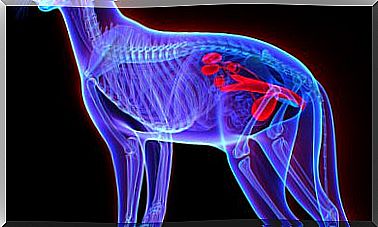What Are The Causes Of Ataxia In Dogs?

There are a huge variety of symptoms in the dog world. Some may not be too obvious if you don’t pay attention, such as changes in the color of the urine or pale mucous membranes. On the other hand, other symptoms are obvious to any observer, such as ataxia or vomiting.
Perhaps the most obvious groups of symptoms are those related to gait and the musculoskeletal system, since any disorder that alters the dog’s gait is very recognizable for the guardian. Today we are going to talk about one of these symptoms, ataxia. Do you know what are the causes of this condition in dogs? Read on to find out.
Definition of ataxia
Ataxia can be defined clinically as a sign of sensory dysfunction that produces staggering or incoordination of the limbs, head or trunk of the animal.
This, translated into a language understandable to all, means that the dog suffering from this disorder walks as if he had had a few more drinks, or at least that is the comment that guardians usually make when they describe this condition in their pets. .
As we have advanced, ataxia itself is not a disease, but a symptom of another underlying pathology. In addition, different diseases usually share the same symptom and in the case of ataxia it could not be otherwise. For this reason, we are going to explain all the possible causes of this worrying symptom.

Neurological causes of ataxia
Ataxia is primarily a neurological symptom. For this reason, diseases and pathological processes that affect the nervous system are going to be the ones that most frequently cause this alteration.
The regulation and control of movements and body position is carried out by several structures, so a disorder in any of them can lead to the appearance of this symptom. Let’s mention some of these diseases.
Cerebellar diseases
The cerebellum is an organ in charge of regulating and modulating nerve impulses, as well as controlling proprioception and the position of the body. Diseases that directly affect the cerebellum can cause ataxia. Among the most frequent we find the following:
- Cerebellar hypoplasia, or what is the same, an underdevelopment of the cerebellum.
- Canine distemper virus.
- Neoplasms – formation of tumors – that affect this organ.
- Granulomatous meningoencephalitis, an inflammatory disease of unknown origin.
Vestibular system diseases
The vestibular system is another essential part of the nervous system that is responsible for receiving, processing and transmitting information related to the position and balance of the animal. Diseases that affect this system can cause ataxia. Among the most common we can find the following:
- Internal otitis or ear infection.
- Geriatric or idiopathic vestibular syndrome.
- Trauma and injuries affecting the inner ear.
Spinal cord diseases
The spinal cord is responsible for transmitting and modulating nerve impulses. Therefore, an alteration at this level can trigger a related disorder such as gait, such as ataxia. In this sense, the spinal cord diseases that cause ataxia are the following:
- Herniated discs.
- Disc protrusions.
- Neoplastic processes.
- Discoespondylitis, an infection in the spine.
- Trauma
- Congenital malformations in the vertebrae.
- Myelopathies, spinal cord compressions.
Other causes of ataxia
There are certain types of ataxia much rarer, but they are there and should be taken into account when trying to perform a correct clinical examination, or in this case, when disclosing quality information.
For example, certain electrolyte disorders such as hypokalaemia – a lack of potassium in the blood – lead to a series of neuromuscular disorders that, on certain occasions, can lead to a clinical picture of ataxia. At the neurological level there is no problem, since ataxia is due solely to a deficiency of potassium or other salts.
Likewise, ataxia is a side effect derived from the administration of certain drugs. For this reason, it is very important that the owner discuss with the veterinarian the complete history of all medications recently used on the animal.
In this sense, although it is infrequent, cases of ataxia have been reported in dogs after the administration of the following medications:
- Antihistamines.
- Acetylpromazine.
- Anticonvulsants

As you have been able to read, ataxia is a sign that in most cases leads to a pathological process that involves the nervous system in one way or another. However, there are other episodes in which, in the absence of neurological disease, the dog may suffer from this symptom.









